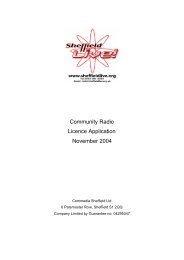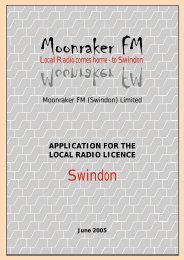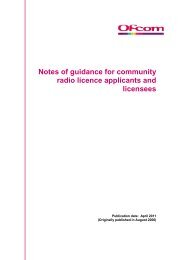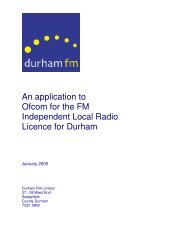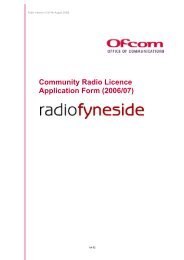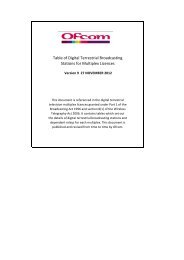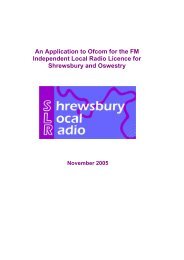MoU for Band 1 between the UK and France - Ofcom Licensing
MoU for Band 1 between the UK and France - Ofcom Licensing
MoU for Band 1 between the UK and France - Ofcom Licensing
You also want an ePaper? Increase the reach of your titles
YUMPU automatically turns print PDFs into web optimized ePapers that Google loves.
MEMORANDUM OF UNDERSTANDING<br />
CONCLUDED BETWEEN<br />
THE ADMINISTRATIONS OF<br />
FRANCE<br />
AND<br />
THE UNITED KINGDOM<br />
ON CO-ORDINATION IN THE<br />
47-68 MHz<br />
FREQUENCY BAND<br />
Page 1 / 13
1. INTRODUCTION<br />
1.1- The 47-68 MHz b<strong>and</strong> is allocated by <strong>the</strong> Radio Regulations to <strong>the</strong> Broadcasting Service on a<br />
primary basis. Additionally, <strong>the</strong> footnote 5.164 allocates this b<strong>and</strong> to <strong>the</strong> L<strong>and</strong> Mobile Service on a<br />
primary basis in CEPT countries, including <strong>France</strong> <strong>and</strong> <strong>the</strong> United Kingdom.<br />
1.2- The Frequency b<strong>and</strong> 47-68 MHz is divided into three sub-b<strong>and</strong>s. The first, 47-54 MHz, is used <strong>for</strong><br />
low power, short range simplex services. The second <strong>and</strong> third sub-b<strong>and</strong>s are a duplex pair, 54-<br />
61 MHz (mobile transmit) <strong>and</strong> 61-68 MHz (base transmit) are designated <strong>for</strong> pan-European L<strong>and</strong><br />
Mobile services according to CEPT Recommendation T/R 25-08.<br />
1.3- In <strong>the</strong> <strong>UK</strong> <strong>the</strong> b<strong>and</strong> 47 – 68 MHz is used <strong>for</strong> <strong>the</strong> l<strong>and</strong> mobile service.<br />
1.4- In <strong>France</strong> <strong>the</strong> b<strong>and</strong> 47-68 MHz is currently used by <strong>the</strong> l<strong>and</strong> mobile <strong>and</strong> broadcasting (television)<br />
services.<br />
1.5- In <strong>France</strong> <strong>and</strong> <strong>the</strong> United Kingdom, different services occupy <strong>the</strong>se frequency b<strong>and</strong>s; due to <strong>the</strong><br />
differing characteristics of <strong>the</strong>se services, separate co-ordination procedures are required in <strong>the</strong><br />
following cases :<br />
- L<strong>and</strong> Mobile in <strong>France</strong> <strong>and</strong> in <strong>the</strong> United Kingdom<br />
- Broadcasting (TV) in <strong>France</strong> <strong>and</strong> L<strong>and</strong> Mobile in <strong>the</strong> United Kingdom<br />
1.6- There<strong>for</strong>e, <strong>the</strong> Administrations of <strong>the</strong> United Kingdom <strong>and</strong> <strong>France</strong> have agreed <strong>the</strong> following coordination<br />
procedures<br />
2 - PROCEDURE FOR FREQUENCY CO-ORDINATION BETWEEN LAND MOBILE<br />
SYSTEMS IN 47-68 MHz FREQUENCY BAND<br />
2.1 - General case<br />
The co-ordination procedure is based on <strong>the</strong> concept of preferential frequencies <strong>and</strong> in accordance with<br />
<strong>the</strong> “2003 Agreement (Berlin, November 2003)” in <strong>for</strong>ce. The 47-54 MHz simplex, 54-61 <strong>and</strong> 61-68<br />
MHz duplex frequency b<strong>and</strong>s will be apportioned as groups of frequencies which can be assigned in an<br />
equitable manner by both countries as "preferential sub-b<strong>and</strong>s". The administrative procedure is<br />
described in paragraph 2.4.<br />
As an exception, systems exempt <strong>for</strong>m co-ordination in paragraph 2.5 should not follow <strong>the</strong> procedure<br />
<strong>for</strong> <strong>the</strong> general case.<br />
2.2 - Technical characteristics<br />
In a preferential sub-b<strong>and</strong> allocated to one country, a base station may be established without prior coordination<br />
if <strong>the</strong> predicted field strength at all points 80 km inside <strong>the</strong> neighbouring country does not<br />
exceed <strong>the</strong> trigger value specified in paragraph 2.2.1.<br />
In a non-preferential sub-b<strong>and</strong> assigned to one country, a base station may be established without prior<br />
co-ordination if <strong>the</strong> predicted field strength at all points on <strong>the</strong> coastline does not exceed <strong>the</strong> trigger<br />
value specified in paragraph 2.2.2. Nei<strong>the</strong>r such a base station nor a mobile served by that station may<br />
Page 2 / 13
complain of interference caused by a station in <strong>the</strong> neighbouring country which complies with <strong>the</strong><br />
conditions laid down <strong>for</strong> <strong>the</strong> use of preferential frequencies.<br />
2.2.1 - Preferential sub-b<strong>and</strong>s<br />
In a preferential sub-b<strong>and</strong>, <strong>the</strong> field strength shall not exceed <strong>the</strong> trigger value of 6 dBµV/m at 10<br />
metres above ground level at all points 80 km inside <strong>the</strong> neighbouring country.<br />
2.2.2 - Non-preferential sub-b<strong>and</strong>s<br />
In a non-preferential sub-b<strong>and</strong>, <strong>the</strong> field strength shall not exceed <strong>the</strong> trigger value of 6 dBµV/m at 10<br />
metres above ground level at all points on <strong>the</strong> coastline of <strong>the</strong> neighbouring country.<br />
2.2.3 - Method <strong>for</strong> <strong>the</strong> Prediction of field strength level<br />
Both administrations shall use <strong>the</strong> HCM software, which includes in particular a sea path algorithm.<br />
2.3 - Preferential frequencies<br />
The division of preferential channels <strong>between</strong> <strong>the</strong> two countries shall be in accordance with Annex 1.<br />
2.4 - Administrative procedure<br />
Where possible, a regular summary of all co-ordinated base stations should be submitted every 6<br />
months. The technical characteristics of L<strong>and</strong> Mobile base stations to be supplied by both<br />
administrations shall be in accordance with <strong>the</strong> <strong>for</strong>mat specified in <strong>the</strong> “2003 Agreement (Berlin,<br />
November 2003) in <strong>for</strong>ce”.<br />
If necessary, in cases where o<strong>the</strong>r technical solutions are not viable, an Administration can request <strong>the</strong><br />
co-ordination of any L<strong>and</strong> mobile Base station which exceed 6 dBµV/m trigger values in paragraphs.<br />
2.2.1 <strong>and</strong> 2.2.2. Frequencies must be co-ordinated in accordance with <strong>the</strong> conditions <strong>and</strong> requirements<br />
defined in <strong>the</strong> “2003 Agreement (Berlin, November 2003) in <strong>for</strong>ce”<br />
2.5 – Systems exempt from co-ordination.<br />
2.5.1 In <strong>the</strong> United Kingdom <strong>the</strong> systems using <strong>the</strong> b<strong>and</strong> 47 - 68 MHz may be short range low power<br />
systems, typically on site. Systems of this type will be exempt from any co-ordination procedure. These<br />
low power systems must fall into at least one of <strong>the</strong> following exemption categories:<br />
a) All systems with an ERP of 500mW or less.<br />
b) All systems with a maximum ERP of 5 W, maximum transmitter antenna height less<br />
than 120m above ground level <strong>and</strong> outside an area 100 km from <strong>the</strong> coast of <strong>the</strong><br />
neighbouring country.<br />
c) All systems with a maximum ERP of 5 W <strong>and</strong> outside an area 200 km from <strong>the</strong><br />
coast of <strong>the</strong> neighbouring country.<br />
Page 3 / 13
2.5.2 Ancillary Broadcast links<br />
In <strong>the</strong> United Kingdom <strong>and</strong> <strong>France</strong> <strong>the</strong> frequency sub-b<strong>and</strong>s contained in Annex 5 are used by<br />
broadcast ancillary links. These links are established on a temporary basis at any location within <strong>the</strong><br />
country. However each administration should ensure that <strong>the</strong>se systems do not cause harmful<br />
interference to existing l<strong>and</strong> mobile services.<br />
3 – PROCEDURE FOR FREQUENCY CO-ORDINATION BETWEEN LAND MOBILE IN<br />
THE UNITED KINGDOM AND TV BROADCASTING IN FRANCE<br />
Frequency co-ordination is necessary in order to protect existing <strong>and</strong> planned services:<br />
- Protection of L<strong>and</strong> Mobile services in <strong>the</strong> United Kingdom from interference caused by TV<br />
broadcasting in <strong>France</strong>;<br />
- Protection of TV broadcasting in <strong>France</strong> from interference caused by L<strong>and</strong> Mobile services in<br />
United Kingdom;<br />
3.1 Protection of TV broadcasting in <strong>France</strong> from interference caused by L<strong>and</strong> Mobile services in<br />
<strong>the</strong> United Kingdom<br />
The existing <strong>and</strong> planned TV Broadcast transmitters must be protected, using <strong>the</strong> co-ordination method<br />
in Annex 2 irrespective of <strong>the</strong> arrangement <strong>for</strong> allocating preferential channels <strong>for</strong> L<strong>and</strong> Mobile coordination,<br />
as shown in Annex 1, noting <strong>the</strong> following exclusions which are not subject to this coordination<br />
procedure:<br />
a) Systems complying with paragraph 2.5<br />
b) All Base Stations more than 500 km from <strong>the</strong> French coast<br />
Calculations relating to interference from mobile services shall be carried out by <strong>the</strong> <strong>UK</strong> using <strong>the</strong><br />
calculation <strong>and</strong> propagation method in Annex 2 so as to ensure <strong>the</strong> minimum interference level to<br />
broadcast reception in <strong>France</strong>.<br />
A list of all existing French TV broadcast transmitters requiring protection is given in Annex 4. The<br />
protection ratios curves <strong>for</strong> L-SECAM transmitters can be found in Rec. ITU-R- IS.851-1. There are<br />
no plans to increase significantly <strong>the</strong> number of <strong>the</strong>se transmitters.<br />
3.2 – Protection of L<strong>and</strong> Mobile services in <strong>the</strong> <strong>UK</strong> from interference caused by TV broadcasting in<br />
<strong>France</strong><br />
The existing French TV broadcast transmitters do not exceed <strong>the</strong> agreed trigger values in this <strong>MoU</strong>.<br />
The introduction of new TV broadcast transmitters that exceed <strong>the</strong> trigger values will require<br />
individual co-ordination.<br />
Calculations relating to interference from TV Broadcasting transmitters shall be carried out by <strong>France</strong><br />
using <strong>the</strong> calculation <strong>and</strong> propagation method in Annex 3 so as to ensure <strong>the</strong> minimum interference<br />
levels to L<strong>and</strong> Mobile stations in <strong>the</strong> United Kingdom.<br />
Page 4 / 13
<strong>France</strong> is not required to provide <strong>the</strong> <strong>UK</strong> with in<strong>for</strong>mation regarding <strong>the</strong> bringing into use of TV<br />
Broadcast Transmitters more than 500 km from <strong>the</strong> United Kingdom coast.<br />
3.3 – Administrative procedure<br />
A regular summary of all co-ordinated base stations shall be submitted every 6 months. The technical<br />
characteristics of L<strong>and</strong> Mobile base stations to be supplied by <strong>the</strong> United Kingdom administration shall<br />
be in accordance with <strong>the</strong> <strong>for</strong>mat specified in <strong>the</strong> “2003 Agreement (Berlin, November 2003) in <strong>for</strong>ce”.<br />
If necessary, in cases where o<strong>the</strong>r technical solutions are not viable, <strong>the</strong> <strong>UK</strong> Administration can request<br />
<strong>the</strong> co-ordination of any L<strong>and</strong> Mobile Base station which exceeds <strong>the</strong> L-SECAM TV transmitter<br />
protection ratios levels in Rec. ITU-R IS.851-1. The French Administration may request any fur<strong>the</strong>r<br />
in<strong>for</strong>mation to assess <strong>the</strong> probability of harmful interference to its TV stations. If agreement is reached,<br />
<strong>the</strong> <strong>UK</strong> Administration may proceed with its project. If <strong>the</strong> French Administration has not replied<br />
within ten weeks following <strong>the</strong> date of <strong>the</strong> consultation letter, it shall be reminded by urgent fax. If <strong>the</strong><br />
French Administration has not replied within two weeks following <strong>the</strong> date of <strong>the</strong> reminder, it is<br />
assumed that <strong>the</strong> station is co-ordinated. In <strong>the</strong> event that more detailed co-ordination is required <strong>the</strong><br />
United Kingdom <strong>and</strong> French administrations shall co-operate to resolve <strong>the</strong> issue in a timely manner.<br />
4 – PROVISIONS RELATING TO CONFIDENTIALITY OF INFORMATION<br />
Both Administrations undertake not to in<strong>for</strong>m <strong>the</strong>ir operators of <strong>the</strong> characteristics of <strong>the</strong>ir<br />
neighbouring Administration’s L<strong>and</strong> Mobile Services.<br />
5 – EXCHANGE OF INFORMATION<br />
For <strong>the</strong> mobile service, exchanges of in<strong>for</strong>mation <strong>for</strong> co-ordination purposes shall be in <strong>the</strong> <strong>for</strong>mat set<br />
out in <strong>the</strong> “2003 Agreement (Berlin, November 2003)” in <strong>for</strong>ce. By preference, a list of new<br />
assignments should be exchanged every six months, by e-mail.<br />
6 – CHANNEL ISLANDS<br />
This Memor<strong>and</strong>um of Underst<strong>and</strong>ing shall not apply to <strong>the</strong> Channel Isl<strong>and</strong>s.<br />
Co-ordination in <strong>the</strong> 47- 68 MHz frequency b<strong>and</strong> will be <strong>the</strong> subject of a separate Memor<strong>and</strong>um of<br />
Underst<strong>and</strong>ing <strong>between</strong> <strong>France</strong> <strong>and</strong> <strong>the</strong> United Kingdom covering <strong>the</strong> Channel Isl<strong>and</strong>s.<br />
7 – CHANNEL TUNNEL<br />
This Memor<strong>and</strong>um of Underst<strong>and</strong>ing shall not apply to <strong>the</strong> Channel Tunnel.<br />
Co-ordination in <strong>the</strong> 47- 68 MHz frequency b<strong>and</strong> <strong>for</strong> L<strong>and</strong> Mobile will be <strong>the</strong> subject of a separate<br />
Memor<strong>and</strong>um of Underst<strong>and</strong>ing <strong>between</strong> <strong>France</strong> <strong>and</strong> <strong>the</strong> United Kingdom covering <strong>the</strong> Channel<br />
Tunnel.<br />
Page 5 / 13
8 – REVISION OF THE MEMORANDUM OF UNDERSTANDING<br />
Ei<strong>the</strong>r Administration may request a revision of this <strong>MoU</strong>. Any part of this <strong>MoU</strong> may be revised in <strong>the</strong><br />
light of future developments <strong>and</strong> experience in <strong>the</strong> operation of <strong>the</strong> networks covered by <strong>the</strong> <strong>MoU</strong>.<br />
9 – TERMINATION OF THE MEMORANDUM OF UNDERSTANDING<br />
Ei<strong>the</strong>r Administration may withdraw from this Memor<strong>and</strong>um of Underst<strong>and</strong>ing subject to 6 months<br />
notice.<br />
10 – LANGUAGE OF THE MEMORANDUM OF UNDERSTANDING<br />
This Memor<strong>and</strong>um of Underst<strong>and</strong>ing exists in French <strong>and</strong> English languages, both texts being equally<br />
authoritative.<br />
The original version in English is laid down with <strong>Ofcom</strong> in London, <strong>the</strong> original version in French is<br />
laid down with <strong>the</strong> Agence Nationale des Fréquences in Maisons-Al<strong>for</strong>t.<br />
11 – DATE OF ENTRY INTO FORCE<br />
This Memor<strong>and</strong>um of Underst<strong>and</strong>ing will enter into <strong>for</strong>ce on 1 st June 2004.<br />
Done at Maisons-Al<strong>for</strong>t on 19 th March 2004,<br />
For FRANCE For <strong>the</strong> UNITED KINGDOM<br />
A. RIGOLE B. LAST<br />
Page 6 / 13
ANNEX 1<br />
DIVISION OF PREFERENTIAL CHANNELS BETWEEN FRANCE AND THE<br />
UNITED KINGDOM (simplex 47-54 MHz)<br />
Preferential Country Start Channel End Channel Simplex Or<br />
Channel. Block<br />
Duplex MTx<br />
No.<br />
First Centre<br />
Frequency<br />
Page 7 / 13<br />
Simplex Or<br />
Duplex MTx<br />
Last Centre<br />
Frequency<br />
Simplex<br />
Or<br />
Duplex<br />
Channel Block<br />
1 FRANCE 1 16 47.00625 47.19375 Simplex<br />
2 <strong>UK</strong> 17 32 47.20625 47.39375 Simplex<br />
3 FRANCE 33 48 47.40625 47.59375 Simplex<br />
4 <strong>UK</strong> 49 64 47.60625 47.79375 Simplex<br />
5 FRANCE 65 80 47.80625 47.99375 Simplex<br />
6 <strong>UK</strong> 81 96 48.00625 48.19375 Simplex<br />
7 FRANCE 97 112 48.20625 48.39375 Simplex<br />
8 <strong>UK</strong> 113 128 48.40625 48.59375 Simplex<br />
9 FRANCE 129 144 48.60625 48.79375 Simplex<br />
10 <strong>UK</strong> 145 160 48.80625 48.99375 Simplex<br />
11 FRANCE 161 176 49.00625 49.19375 Simplex<br />
12 <strong>UK</strong> 177 192 49.20625 49.39375 Simplex<br />
13 FRANCE 193 208 49.40625 49.59375 Simplex<br />
14 <strong>UK</strong> 209 224 49.60625 49.79375 Simplex<br />
15 FRANCE 225 240 49.80625 49.99375 Simplex<br />
16 <strong>UK</strong> 241 256 50.00625 50.19375 Simplex<br />
17 FRANCE 257 272 50.20625 50.39375 Simplex<br />
18 <strong>UK</strong> 273 288 50.40625 50.59375 Simplex<br />
19 FRANCE 289 304 50.60625 50.79375 Simplex<br />
20 <strong>UK</strong> 305 320 50.80625 50.99375 Simplex<br />
21 FRANCE 321 336 51.00625 51.19375 Simplex<br />
22 <strong>UK</strong> 337 352 51.20625 51.39375 Simplex<br />
23 FRANCE 353 368 51.40625 51.59375 Simplex<br />
24 <strong>UK</strong> 369 384 51.60625 51.79375 Simplex<br />
25 FRANCE 385 400 51.80625 51.99375 Simplex<br />
26 <strong>UK</strong> 401 416 52.00625 52.19375 Simplex<br />
27 FRANCE 417 432 52.20625 52.39375 Simplex<br />
28 <strong>UK</strong> 433 448 52.40625 52.59375 Simplex<br />
29 FRANCE 449 464 52.60625 52.79375 Simplex<br />
30 <strong>UK</strong> 465 480 52.80625 52.99375 Simplex<br />
31 FRANCE 481 496 53.00625 53.19375 Simplex<br />
32 <strong>UK</strong> 497 512 53.20625 53.39375 Simplex<br />
33 FRANCE 513 528 53.40625 53.59375 Simplex<br />
34 <strong>UK</strong> 529 544 53.60625 53.79375 Simplex<br />
35 FRANCE 545 560 53.80625 53.99375 Simplex
ANNEX 1<br />
DIVISION OF PREFERENTIAL CHANNELS BETWEEN<br />
FRANCE AND THE UNITED KINGDOM (duplex 54-68MHz)<br />
Preferential Country Start Channel End Channel Simplex Or<br />
Channel. Block<br />
Duplex MTx<br />
No.<br />
First Centre<br />
Frequency<br />
Page 8 / 13<br />
Simplex Or<br />
Duplex MTx<br />
First Centre<br />
Frequency<br />
Simplex<br />
Or<br />
Duplex<br />
Channel Block<br />
Duplex BTx<br />
First Centre<br />
Frequency<br />
Duplex BTx<br />
First Centre<br />
Frequency<br />
36 <strong>UK</strong> 561 576 54.00625 54.19375 Simplex Guard-b<strong>and</strong> (MTx to-BTx)<br />
37 FRANCE 577 592 54.20625 54.39375 Duplex 61.20625 61.39375<br />
38 <strong>UK</strong> 593 608 54.40625 54.59375 Duplex 61.40625 61.59375<br />
39 FRANCE 609 624 54.60625 54.79375 Duplex 61.60625 61.79375<br />
40 <strong>UK</strong> 625 640 54.80625 54.99375 Duplex 61.80625 61.99375<br />
41 FRANCE 641 656 55.00625 55.19375 Duplex 62.00625 62.19375<br />
42 <strong>UK</strong> 657 672 55.20625 55.39375 Duplex 62.20625 62.39375<br />
43 FRANCE 673 688 55.40625 55.59375 Duplex 62.40625 62.59375<br />
44 <strong>UK</strong> 689 704 55.60625 55.79375 Duplex 62.60625 62.79375<br />
45 FRANCE 705 720 55.80625 55.99375 Duplex 62.80625 62.99375<br />
46 <strong>UK</strong> 721 736 56.00625 56.19375 Duplex 63.00625 63.19375<br />
47 FRANCE 737 752 56.20625 56.39375 Duplex 63.20625 63.39375<br />
48 <strong>UK</strong> 753 768 56.40625 56.59375 Duplex 63.40625 63.59375<br />
49 FRANCE 769 784 56.60625 56.79375 Duplex 63.60625 63.79375<br />
50 <strong>UK</strong> 785 800 56.80625 56.99375 Duplex 63.80625 63.99375<br />
51 FRANCE 801 816 57.00625 57.19375 Duplex 64.00625 64.19375<br />
52 <strong>UK</strong> 817 832 57.20625 57.39375 Duplex 64.20625 64.39375<br />
53 FRANCE 833 848 57.40625 57.59375 Duplex 64.40625 64.59375<br />
54 <strong>UK</strong> 849 864 57.60625 57.79375 Duplex 64.60625 64.79375<br />
55 FRANCE 865 880 57.80625 57.99375 Duplex 64.80625 64.99375<br />
56 <strong>UK</strong> 881 896 58.00625 58.19375 Duplex 65.00625 65.19375<br />
57 FRANCE 897 912 58.20625 58.39375 Duplex 65.20625 65.39375<br />
58 <strong>UK</strong> 913 928 58.40625 58.59375 Duplex 65.40625 65.59375<br />
59 FRANCE 929 944 58.60625 58.79375 Duplex 65.60625 65.79375<br />
60 <strong>UK</strong> 945 960 58.80625 58.99375 Duplex 65.80625 65.99375<br />
61 FRANCE 961 976 59.00625 59.19375 Duplex 66.00625 66.19375<br />
62 <strong>UK</strong> 977 992 59.20625 59.39375 Duplex 66.20625 66.39375<br />
63 FRANCE 993 1008 59.40625 59.59375 Duplex 66.40625 66.59375<br />
64 <strong>UK</strong> 1009 1024 59.60625 59.79375 Duplex 66.60625 66.79375<br />
65 FRANCE 1025 1040 59.80625 59.99375 Duplex 66.80625 66.99375<br />
66 <strong>UK</strong> 1041 1056 60.00625 60.19375 Duplex 67.00625 67.19375<br />
67 FRANCE 1057 1072 60.20625 60.39375 Duplex 67.20625 67.39375<br />
69 <strong>UK</strong> 1073 1088 60.40625 60.59375 Duplex 67.40625 67.59375<br />
65 FRANCE 1089 1104 60.60625 60.79375 Duplex 67.60625 67.79375<br />
70 <strong>UK</strong> 1105 1120 60.80625 60.99375 Duplex 67.80625 67.99375
ANNEX 2<br />
CO-ORDINATION METHOD FOR THE PROTECTION OF TV<br />
BROADCASTING IN FRANCE FROM INTERFERENCE CAUSED BY<br />
LAND MOBILE SERVICES IN THE <strong>UK</strong><br />
The minimum median value of <strong>the</strong> field strength to be protected in <strong>the</strong> television service in <strong>B<strong>and</strong></strong> I is<br />
46 dBμV/m, from table I of ITU-R Recommendation IS.851.<br />
This field strength shall not be exceeded, at <strong>the</strong> coastline of <strong>France</strong> in <strong>the</strong> frequency b<strong>and</strong> 47-68 MHz,<br />
by <strong>the</strong> usable field strength of <strong>the</strong> l<strong>and</strong> mobile service in <strong>the</strong> United Kingdom when calculated<br />
according to <strong>the</strong> simplified multiplication method as detailed in Appendix 1 of Annex 1 of ITU-R<br />
Recommendation IS.851.<br />
Calculations shall include all l<strong>and</strong> mobile base stations within 300 km of <strong>the</strong> French Coast (400 km if<br />
<strong>the</strong> effective antenna height exceeds 200 m).<br />
The nuisance field strength from each base station site shall be determined from :<br />
E = 10 Log<br />
N<br />
10∑<br />
i=<br />
1<br />
10<br />
Ei<br />
10<br />
Where “N” is <strong>the</strong> number of transmitters on <strong>the</strong> site, <strong>and</strong>:<br />
Where<br />
E = E + A + B<br />
i<br />
ni<br />
i<br />
i<br />
Eni is <strong>the</strong> interfering field strength at <strong>the</strong> French coast of <strong>the</strong> i-th transmitter. This value shall be<br />
determined using <strong>the</strong> ITU-R Recommendation PN1546 curves, <strong>for</strong> <strong>the</strong> case of 10 % time,<br />
50 % location <strong>and</strong> h2 = 10 m.<br />
Ai is <strong>the</strong> Radio frequency protection ratio associated with <strong>the</strong> i-th transmitter. This value shall be<br />
determined from tables 3, 5 <strong>and</strong> figure 2 of ITU Recommendation IS.851 (tropospheric<br />
interference), noting that <strong>for</strong> some paths <strong>the</strong> interference may be continuous.<br />
Bi is <strong>the</strong> receiving antenna discrimination factor associated with <strong>the</strong> i-th transmitter. It shall be<br />
-16 dB <strong>for</strong> horizontally polarised Broadcasting transmitters in <strong>France</strong>, <strong>and</strong> equal to <strong>the</strong> receiving<br />
antenna directivity discrimination, according to Recommendation ITU-R BT 419 <strong>for</strong> vertically<br />
polarised Broadcasting transmitters in <strong>France</strong>.<br />
The nuisance fields from mobile stations shall be calculated according to section 4.1.3 <strong>and</strong> 4.1.4<br />
of ITU-R Recommendation IS.851 i.e. by considering <strong>the</strong> mobile station as located at <strong>the</strong> same<br />
place as <strong>the</strong> base station, with an effective height of 75 m <strong>and</strong> an adjustment factor of -15 dB.<br />
Page 9 / 13
Explanatory note<br />
Within <strong>the</strong> b<strong>and</strong>width of a television channel <strong>the</strong>re is <strong>the</strong> potential to use up to 500 mobile channels.<br />
Multiple narrow-b<strong>and</strong> transmissions may produce additional interfering effect into <strong>the</strong> relatively<br />
broadb<strong>and</strong> television signal. The addition from a single site will be a power addition as detailed above.<br />
From different sites however an attempt should be made to use <strong>the</strong> statistical (in locations) nature of<br />
propagation <strong>and</strong> <strong>the</strong> simplified multiplication method is appropriate.<br />
The protection ratio <strong>for</strong> <strong>the</strong> television signal is not constant over <strong>the</strong> television channel <strong>and</strong> thus an<br />
individual value is used <strong>for</strong> each mobile channel. Advantage is taken of <strong>the</strong> horizontal polarisation<br />
used in <strong>France</strong> by including an antenna discrimination factor.<br />
Mobile stations will produce a smaller interfering effect than base stations because of <strong>the</strong>ir lower<br />
antenna height above ground, leading to greater shielding by terrain <strong>and</strong> buildings, <strong>and</strong> because of <strong>the</strong>ir<br />
typically lower radiated power. A global reduction of 15 dB is assumed to allow <strong>for</strong> <strong>the</strong>se factors.<br />
Page 10 / 13
ANNEX 3<br />
CO-ORDINATION METHOD FOR THE PROTECTION OF LAND MOBILE<br />
SERVICES IN THE <strong>UK</strong> FROM INTERFERENCE CAUSED BY TV<br />
BROADCASTING IN FRANCE<br />
The maximum interfering field strength measured in a 12.5 kHz b<strong>and</strong>width <strong>for</strong> 50% locations <strong>and</strong> 10%<br />
of <strong>the</strong> time at a height of 10m above ground shall be:<br />
30 dBµV/m <strong>for</strong> horizontally polarised broadcasting emissions (12 dBµV/m Interfering F.S.+18 dB<br />
cross polarisation)<br />
12 dBµV/m <strong>for</strong> vertically polarised broadcasting emissions<br />
This field strength shall not be exceeded at <strong>the</strong> coastline of <strong>the</strong> United Kingdom in <strong>the</strong> frequency b<strong>and</strong><br />
47- 68 MHz.<br />
For <strong>the</strong> purpose of calculation, ITU-R Recommendation PN.1546 shall be used <strong>for</strong> <strong>the</strong> case of 10%<br />
time, 50 % locations <strong>and</strong> h2= 10m.<br />
Explanatory Note:<br />
In <strong>the</strong> b<strong>and</strong> 47-68 MHz, <strong>the</strong> minimum median value of <strong>the</strong> field strength to be protected <strong>for</strong> analogue<br />
systems using 12.5 kHz channel is 22 dBµV/m signal quality 4, from Table 14 <strong>and</strong> note (1) of ITU-R<br />
Recommendation IS. 851.<br />
The protection ratio <strong>for</strong> analogue l<strong>and</strong> mobile systems is 10 dB, from Table 16 of ITU-R<br />
Recommendation IS. 851.<br />
The adjustment factor <strong>for</strong> cross polarisation emissions is –18 dB, from section 4.1 of ITU-R<br />
Recommendation IS. 851.<br />
Page 11 / 13
ANNEX 4<br />
TV BROADCAST TRANSMITTERS IN FRANCE REQUIRING PROTECTION<br />
TV Transmitter Site<br />
CAEN<br />
CHARTRES<br />
BREST<br />
NANTES<br />
CHERBOURG<br />
AMIENS<br />
RENNES<br />
LE HAVRE<br />
LA ROCHE-SUR-YON<br />
QUIMPERLE<br />
LPS: Low Power Systems<br />
LM: L<strong>and</strong> Mobile<br />
LONG/LAT<br />
0037W 4858N<br />
0101E 48.24N<br />
0353W 4825N<br />
0126W 4711N<br />
0133W 4937N<br />
0224E 4931N<br />
0157W 4817N<br />
0011E 4931N<br />
0125W 4640N<br />
0333W 4752N<br />
SECAM<br />
Channel<br />
2 H<br />
2V<br />
2V<br />
2H<br />
2H<br />
2H<br />
4H<br />
4H<br />
4H<br />
4H<br />
Vision<br />
MHz<br />
55.75<br />
55.75<br />
55.75<br />
55.75<br />
55.75<br />
55.75<br />
63.75<br />
63.75<br />
63.75<br />
63.75<br />
Page 12 / 13<br />
Sound<br />
MHz<br />
49.25<br />
49.25<br />
49.25<br />
49.25<br />
49.25<br />
49.25<br />
57.25<br />
57.25<br />
57.25<br />
57.25<br />
Max Erp<br />
(kW)<br />
50<br />
1<br />
1<br />
1<br />
1<br />
1<br />
10<br />
2<br />
0.015<br />
0.001<br />
<strong>UK</strong><br />
Systems<br />
LPS<br />
LPS<br />
LPS<br />
LPS<br />
LPS<br />
LPS<br />
LPS/LM<br />
LPS/LM<br />
LPS/LM<br />
LPS/LM
Sound links in <strong>UK</strong><br />
Frequency<br />
<strong>B<strong>and</strong></strong>width Class of<br />
Power Max/Min Emission<br />
47.55 48.8 MHz 25 W 200k0 F1D__ F2D__<br />
F3E__ F7D__<br />
12k5<br />
F8E __ F9E__<br />
52 52.95 MHz 25 W 200k0<br />
F9W__ G3E__<br />
F1D__ F2D__<br />
F3E__ F7D__<br />
12k5<br />
F8E__ F9E__<br />
F9W__ G3E__<br />
53.75 55 .75 MHz 5 W 200k0 F1D__ F2D<br />
F3E__ F7D__<br />
__<br />
12k5<br />
F8E__ F9E__<br />
F9W__ G3E__<br />
60.75 62.75 MHz 5 W 200k0 F1D__ F2D__<br />
F3E__ F7D__<br />
12k5<br />
F8E__ F9E__<br />
F9W__ G3E__<br />
67.7500 67.8375MHz 2 5 W 12k5 F1D__ F2D__<br />
F3E__ F7D__<br />
F8E__ F9E__<br />
F9W__ G3E__<br />
Sound links in <strong>France</strong><br />
ANNEX 5<br />
ANCILLARY BROADCAST LINKS<br />
Page 13 / 13<br />
Licensed apparatus/Restrictions<br />
On a non -interference basis to continental broadcasting.<br />
On a non -interference basis to continental broadcasting.<br />
On a non -interference basis to continental broadcasting.<br />
On a non -interference basis to continental broadcasting.<br />
On a non -interference basis to continental broadcasting.<br />
Frequency <strong>B<strong>and</strong></strong>width Comments<br />
47,0125-47,1125 MHz paired with 50,0125-50,1125 MHz 4 channel duplex 25 kHz<br />
47,5 MHz paired with 50,5 MHz Single channel duplex 25 kHz Only in Paris area<br />
47,7 MHz paired with 50,7 MHz Single channel duplex 25 kHz<br />
53 MHz Single channel simplex 25 kHz





